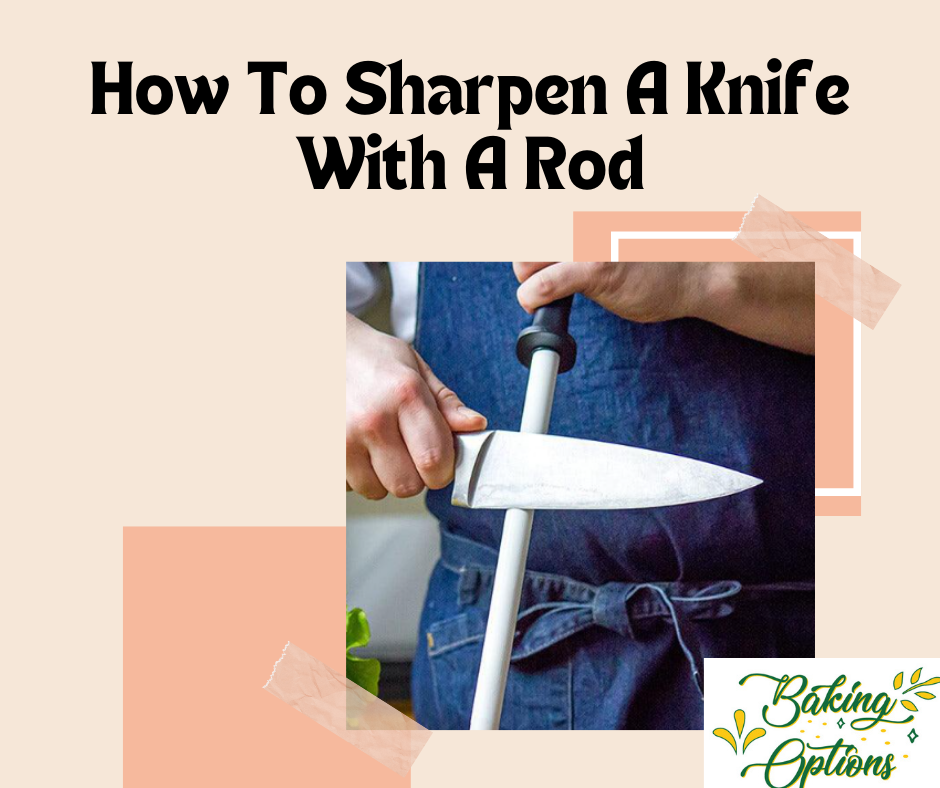If there is a rod in your kitchen or you are considering buying one, my grandmother gave me a set of kitchen tools, including a rod whose purpose I didn’t know at first. After searching the internet, I discovered its essential use is for sharpening blades and smoothing dull surfaces.
However, I didn’t know how to sharpen a knife with a rod. Since I don’t know how to use it properly
If you want one or want to buy one from me, it’s a handy item; you must know how to use it correctly. It can make your knives perfectly sharp.
In this article, I will teach you how to use it properly, and yes, I will also discuss safety measures because where knives or blades are involved, safety and security are paramount, helping to avoid injuries and cuts. It’s time for me to get into the article now.
Contents
- 1 What is a knife sharpening rod?
- 2 Types of Knife Sharpening Rods
- 3 How To Select The Right Rod For Your Knives?
- 4 How to Sharpen Knife With a Rod
- 5 The Pros and Cons of Sharpening Your Knife with a Rod
- 6 How to Take Care Of Your Rod Knife Sharpener
- 7 Simple Way To Get The Best Results After Knife Sharpening
What is a knife sharpening rod?
A knife sharpening or honing rod maintains that sharpness in a knife. It can be produced from stainless steel, ceramic, or diamond and has different sizes, shapes, and thicknesses.
Unlike other sharpening tools that involve taking metal off the blade, a honing rod aligns the knife’s edge to make it sharper. You hold the rod at a slight angle and slide the knife over it a few times to use it. This process assists in preserving the knife’s lifespan and ensures it is always ready for use.
Types of Knife Sharpening Rods
Steel Rods
Steel rods are used most commonly. It’s the best choice if you’re looking to sharpen dull blades. When you use this, it realigns the edges of the knife, automatically making it very sharp. I really like this feature because you can use it for a long time.
You wouldn’t believe that the rod I have has been with me for 5 years and is still in perfect condition. As far as I know, professional chefs usually use this rod type.
Ceramic Rods
Ceramic rods are another great option on the market, especially for sharp knives. They are harder than steel rods, as this makes them scrub the blade’s edge and shave a little metal to sharpen it.
It makes ceramic rods especially ideal for sharpening and maintaining the sharpness of a knife blade before the next sharpening session. Ceramic rods help preserve the knife’s edge for some people without the need for sharpening frequently.
Diamond Rods
Diamond rods are the coarsest type you can get and are ideal for sharpening knives with extremely blunt edges. They can also shave material off the blade much faster than the steel ceramic rods, making them particularly suitable for restoring the cutting edge of a blade.
Although diamond rods are somewhat costly compared to other types of brushes, they are very effective and thus deemed worth the cost, especially for regular users of hard or premium-quality knives.
How To Select The Right Rod For Your Knives?
We know about rods and how they work, but we often don’t know which type of rod is best for sharpening which kind of knife. I will clarify this concept with the help of a small table. After reading this small table, I hope you can select the suitable rods.
| Knife Type | Recommend Rod | Reason |
| Dull Knife | Steel Rod | For honing & sharpening |
| Serrated Knife | Ceramic Rod | To keep the serrated edge sharp |
| Premium Knife | Diamond Rod | To preserve the blade’s edge |
- Knife Length: Select a rod that is the same length as your knife.
- General Use: Always follow the instructions provided by the manufacturer.
How to Sharpen Knife With a Rod
The process of sharpening the knife will not change regardless of the rod you use. I will go over how to sharpen the blade with this step-by-step.
What You Need For it
- A knife that needs sharpening
- A sharpening rod (steel, diamond, or ceramic)
- A stable surface (like a countertop)
- A paper towel or moist cloth (for cleaning)
Step-By-Step Instructions
- Clean Work Area
Find a flat surface free of debris big enough to move the knife about quickly. Be sure there is adequate space for knife movement.
- Grip Rod
Hold the sharpening rod vertically against your counter and grasp the handle securely. If the rod has a base, secure the rod by spreading it across your countertop.
- Insert Knife
Hold the knife with your dominating hand. Now spread the blade at approximately 20 degrees to the rod. The end of the knife should be at the very top of the rod.
- Begin Sharpening
Slide the knife down the rod gently while pulling it towards you. Use smooth, even strokes, maintaining the 20-degree angle throughout the motion. Repeat this action about 5 to 10 times on each side of the blade.
- Switch Sides
After sharpening one side of the KnifeKnife, switch to the other and repeat the same process. This ensures that both sides of the blade are sharp enough.
- Check Sharpness
After sharpening, carefully test the knife’s sharpness by slicing through a piece of paper or a tomato. If it cuts easily, you’ve done a great job!
- Clean Your Knife and Rod
Wipe down the knife with a damp cloth or paper towel to remove any metal shavings. Clean the sharpening rod to keep it in good condition for future use.
- Store Properly
Store your knife safely in a block or sheath to protect its edge, and keep your sharpening rod in a dry place. Following these steps, you can effectively sharpen your knives using a rod, ensuring they remain sharp and ready for all your cooking tasks.
The Pros and Cons of Sharpening Your Knife with a Rod
Pros: A honing rod allows sharpening quickly and easily, a very convenient maintenance feature. The process is much less likely to damage the blade than sharpening it with a stone.
Cons: A rod does not remove as much metal from the blade as a sharpening stone and may not form an edge quite as sharp. It is more effective for honing and maintaining an already sharp knife than fixing a dull one.
How to Take Care Of Your Rod Knife Sharpener
Clean After Use
Wipe your rod with a clean, dry cloth after each use. It’ll eliminate the grit or debris that may make the blade dull.
Proper Storage
Store your rod in a dry, safe place. A kitchen drawer or cabinet is perfect because it protects it.
Avoid the Dishwasher
Under no circumstances should you put your rod in the dishwasher. The chemicals used can be harsh, and the heat is a nightmare for the blade.
Sharpening Your Rod
If your rod starts to dull, you can sharpen it using a honing rod:
Find a Matching Honing Rod
Choose a honing rod the same size as your sharpening rod.
Angle the Honing Rod
Maintain a 20-degree angle between the honing rod and the blade.
Sharpening Motion
Move the honing rod from the heel to the blade’s tip, applying even pressure on both sides.
Rinse and Dry
After sharpening, rinse the blade with water and dry it off before using it again.
Simple Way To Get The Best Results After Knife Sharpening
A few more vital tips need to be kept in mind so that the maximum benefit of knife sharpening through a rod can be attained: First, place the rod correctly at the sharpener, i.e., the required angle of positioning the rod varies between 10 and 20 degrees, without which no decent sharpening occurs.
Even smooth pressure throughout the sharpening process also forms a critical stage for perfect sharpness, as sharpness varies per uniform blade sharpening by applying steady pressure.
Finally, remember to sharpen the blade only in one way. Sharpening back and forth dulls the blade faster and loses its effectiveness quicker.
By recognizing these simple guidelines, you should get excellent results when using a rod to sharpen your knife. After it, you will learn how to sharpen a knife with a rod in an effective way.

